Depending on your sources, you’ve likely heard that football is 50% luck. Others, most often former players or coaches, will offer a range of 0 to 20% luck in any outcome.
Luck surely factors into any match, but that doesn’t minimise the significance of an opposition scouting report. In fact, you could argue that we make our own luck. In any seemingly lucky event, actions from the beneficiary nearly always impact the sequence. Thorough knowledge of the opposition minimises the luck factor, preparing a squad to recognise patterns and respond appropriately.
Detail is king. During his time as José Mourinho’s Chief Opposition Scout, André Villas-Boas said the following about his head coach and scouting expectations: “Jose is obsessed with detail – He will leave nothing to chance, even if his team are playing the worst side in the league. My work enables Jose to know exactly when a player from the opposition is likely to be at his best or his weakest.” Basically, Jose decided to pay someone to write my paper and Andre did the business.
This article offers an extensive approach to constructing opposition scout reports. Data-driven research, tactical analysis, important questions and suggestions for studying the opposition offer a guide for a comprehensive report. With the research on hand, attention turns to red teaming and presentations. No stone is left unturned in this report.
Before you watch matches
Before your opposition analysis team starts pouring over the opposition’s match footage, data analysis can help your side determine a tactical profile, identify key players and discover patterns of play. A proficient data visualisation team can greatly expedite your opposition analysis and coaching staff’s learning curve. Quantitative team profiles of your opponents, your own team and league will help you classify the opposition, grouping comparable levels of talent and similarities in playing styles.
With a data-driven team profile in hand, studying the right matches is the next step. Using a combination of recent matches, starting XI, and opponents with similar style and ability to your own team will help you narrow down the best matches to study. Going back to the team profiles, if you know which teams show the greatest degree of similarity to your own, you can then watch match footage of that club versus your next opponent. You’ll want to identify what worked, what didn’t and necessary adjustments from a hindsight perspective. The starting XIs in those games are likely to shed light on the side you’ll encounter.
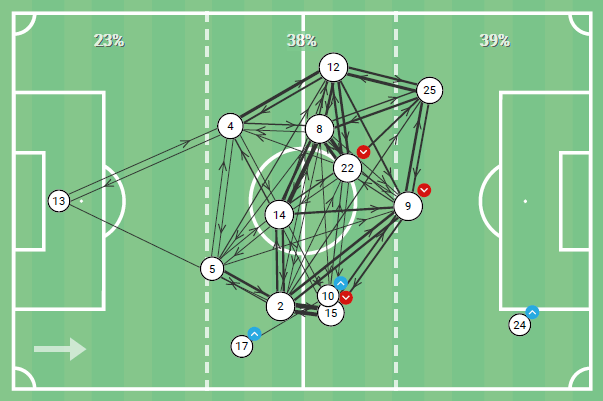
In addition to squads with similar playing styles, the two or three most recent matches will give you insights into the most recent patterns and trends. Maps of player and team activity, like the Real Madrid’s pass map, offer insight into key connections. Notes regarding recent form and tactics will help your staff construct the best approach, as well as offer insights into the mentality of the squad. Finally, knowing the opposition’s injury status will help you narrow down the possible variations in the starting XI.
Attacking Structure
A team’s formation offers a basic idea of where to find pockets of space and where the opposition are most likely to funnel their attack. Further, with a knowledge of the opposition’s players, an opposition analyst or coaching staff will know how the expected starting XI and formation fit into the opponent’s general tactics.
This is macro-level, which you must know, but it certainly doesn’t tell the whole story. Digging into the micro-levels reveals much greater clarity of tactics and helps you pinpoint specific threats and patterns.
For example, say you were coaching against Barcelona and I told you they play a 4-3-3 and that they like to build out of the back. While that’s good to know, I haven’t given you any information beyond what a common game fan would know. Knowing they like to play out of the back, I can then look for patterns of build-up and phase-specific objectives. Detailing this information is of far more value than the surface-level remarks.
When examining an opponent’s attacking structure, your scout reports should flow through the four phases of attack:
1) playing from the back
2) connecting the lines
3) the final pass
4) finishing
If you prefer a three-phase model (preparing to attack the opponents, attacking the opponents and attacking the goal), that’s fine too. It’s basically a consolidated version of the four-phase model. Regardless of your preference, the objective is to discover the opponent’s tactical intent in each phase. Accounting for the who, what, when, where, why and how paints the bigger picture with attention to the finer details.
1) Playing from the back
Starting in the first phase, we want to identify whether the opposition will tend to play direct or indirect. Long passes per 90 is a strong statistical category to analyse, as is a look at the distribution tendencies of the goalkeeper and centre-backs. If the side features a target forward or and less technical centre-backs, the odds of a more direct approach are likely.
Then, once we have a general understanding of their phase one tendencies, it’s time to investigate the side’s attacking shape and the patterns of play that emerge.
If the opponent’s attacking shape is habitually narrow in the build-up, expect a low-risk approach to possession. Instead of a true build-up, expect them to skip lines early in an attempt to limit your opportunities for a high recovery. In this setup, you need to identify the high targets or clusters of attackers. Are they looking to set back or flick on? Are they more likely to target one area of the pitch above others? Who sends the long ball and what cues does he need to see before playing forward?
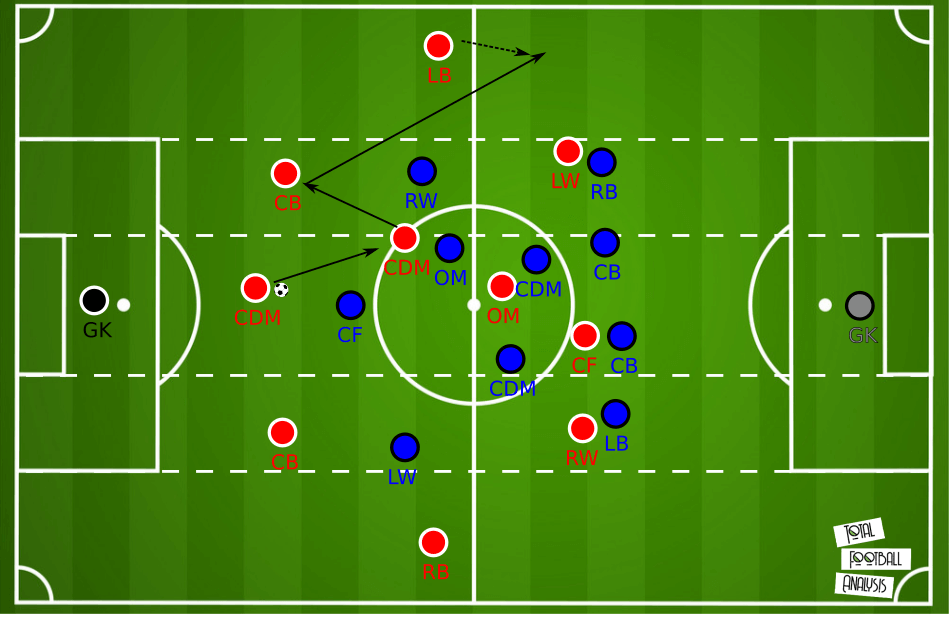
With a team that prefers, maybe even insists, to build out of the back, greater scrutiny is necessary. Identifying patterns of play and how the attacking shape evolves over the course of the build-out is a necessity. You need to identify who drops in, like the #6 in the image above, which players shift higher up the pitch and where the opponent wants to unbalance your side. Additionally, studying the movement higher up the pitch is critical. What cues signal progression from the deeper players? Who are they likely to target once you’re unbalanced? Does there build-up exhibit any weakness we can exploit? Knowing the answers to those questions will help you fit this portion of the opponent’s attacking tactics into the big picture.
2) Connecting the lines
Connecting the lines follows from building out of the back. To an extent, they are connected. If the opposition has the ball in their own half of the pitch, the odds of progressing to connecting the lines are highly likely.
When the opponent recycles play in your half, you’ll want to determine common patterns of ball and player movement. If it’s a cross heavy team, will they attempt to possess centrally to open up a wing for the outside-back? Are they a side that uses a full switch of play to get into the half spaces? How proficient are they at central penetration? If they excel in that area, which players will they target? How does that player navigate space and numbers through his relationships with teammates?
3) The Final Pass
At first glance, the final pass seems rather simple. Your first step is likely to determine if the team leans heavily on crosses, through balls, central combinations or a more balanced approach. However, much like the progression from the build-out to connecting the lines, certain cues higher up the pitch will dictate action from deeper areas.
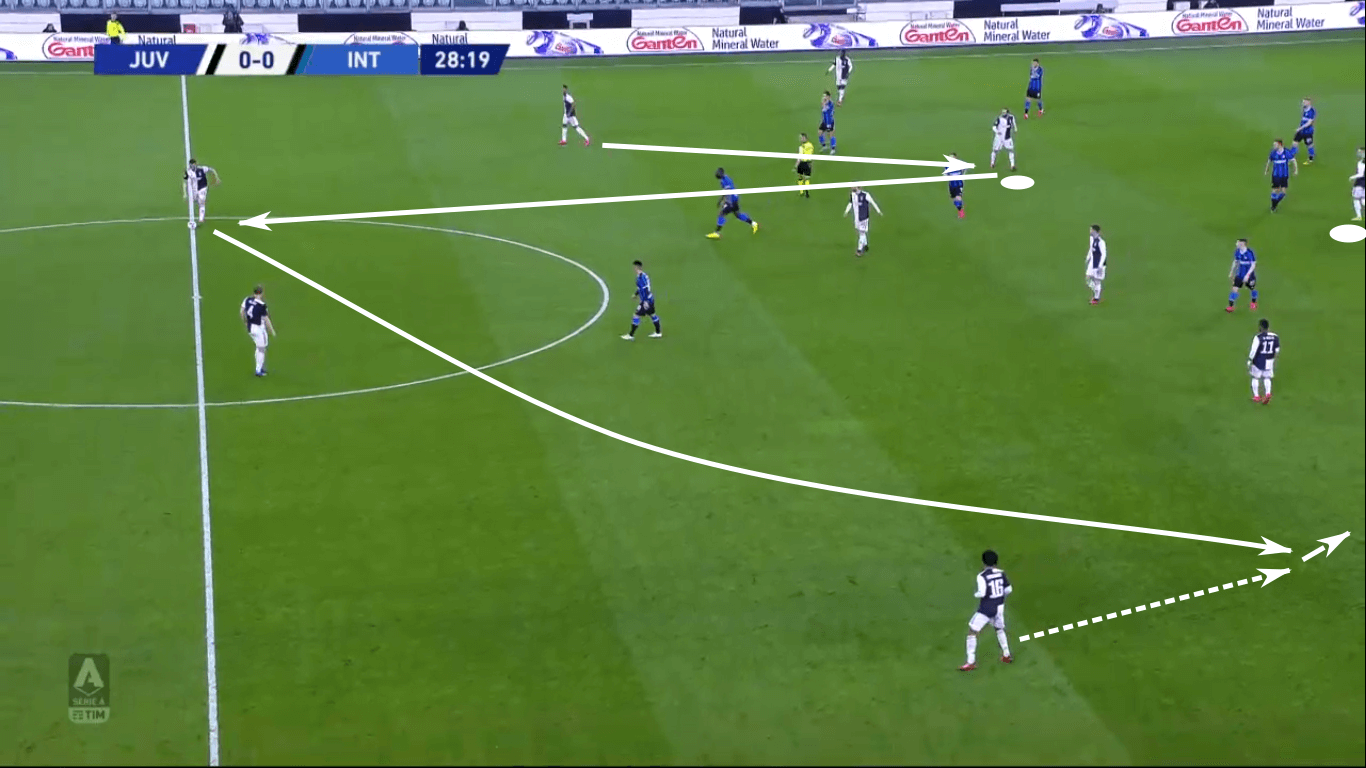
If the team relies heavily on crosses, you’ll want to determine the step preceding the cross, as well as when they send it. Some players and teams prefer early crosses, forcing opponents to retreat to goal, typically against quick opponents. Others might have dominant aerial threats and invite you to retreat back to the 6-yard box, losing your marker in the process, before sending a cross. More efficient sides will also wait for adequate numbers or a qualitative advantage before sending the cross, meaning ball circulation attempts to free those higher attackers, giving them direct routes to the box in numbers. The image above replicates this situation with Juventus connecting on the left before switching play to the right. That allowed Cristiano Ronaldo and Gonzalo Higuaín to move from their left-sided starting points to a more central partnership.
If the side sends many through balls, identifying the defensive errors leading up to the pass is key. When your opponent was successful in previous matches, did they target a specific vertical channel, such as the half-space? Did a #9 pull a centre-back out of the backline’s structure? Discovering how they created the passing lane and who the most likely runners are is vital to your tactics.
Finally, with central combinations, teams often target a player between the lines. Some will ask the forwards to make runs in behind, creating a gap in the midfield. Others will utilise the defenders, encouraging the opposition to move high up the pitch, resulting in more space between the lines. Regardless of the entry, identifying the target areas and players who generally receive in that space will direct your attention to the movement and ball circulation patterns that precede the pass. Then, once the pass is made, which combinations does the opposition use to complete the final pass and how can your side adjust to eliminate the threat.
4) Finishing
Wrapping up attacking structures is everyone’s favourite category, finishing. This is deeply connected to the final pass. As such, brevity is preferred. How does a side get their goals? Where are their best and worst xG ratings? Is there any one player who excels in front of the net? If so, what types of finishes does he utilise? Also, is there a specific area where shot volume is higher than others?
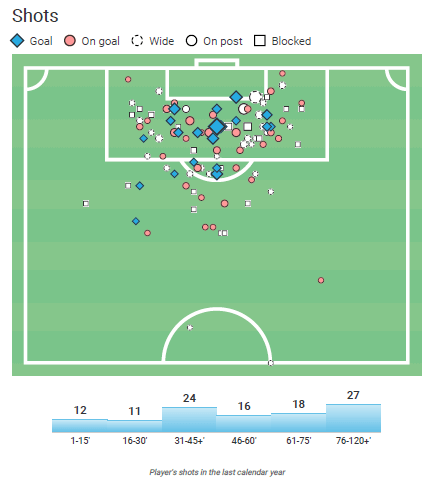
Relating to basketball, many players have “their spot” on the floor. Suppose you discover an opponent likes to shoot from specific areas of the pitch. In that case, your tactics should include denying entry into that area unless he’s a terrible finisher from that spot. Shot maps, like the one above for Luís Suárezcounter-pressing of Barcelona, offer insights into shot selection.
Defensive structure
When evaluating a team’s defensive structure, a number of items must come into consideration. For instance, what type of block are they most likely to use? Are they an aggressive counter-pressing club? You’ll also want to determine which spaces they prioritise and which are more accessible. Beneath the tactics, figuring out where and how the defence wants you to play will play into your match tactics.
General characteristics
Some teams are consistent with their approach to defensive blocks, others will add slight variations specific to the match up. Determining your opponent’s press approach is the starting place. If the side consistently uses a high block, plan on it, but also watch sequences in which they’re driven back to their defensive third. If the high press is broken, how does the defence adapt? Do they move into a middle block? Does the length of the recovery force them deep into a low block? You’ll want to know how they recover and where to exploit their lack of structure.
If the opponent plays in a middle or low block, watch the width of their shape, as well as the amount of space they concede behind the lines.
Pressure cues
A team’s press is their basic defensive structure. Within that structure, they’re looking for cues that signal it’s time to get to the first attacker/ball carrier and pressure. Pressing traps could be universal, such as a poor first touch, bad body orientation or a negative pass (as in the image below), but they can also relate to players or zones of the pitch.
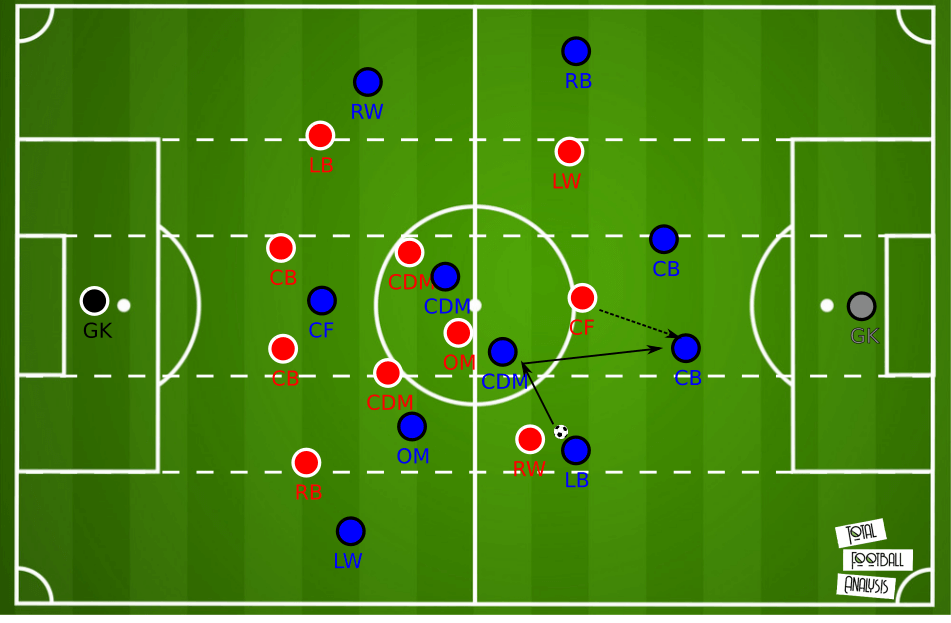
A common pressing scheme in a 4-3-3 is using the forwards to funnel play to the inside, then overwhelming the opponent in the central channel. Other systems want to keep you out of the middle, forcing your team into the wings and then condensing the field horizontally. Identifying the pressure cues will help your team avoid traps and, if you plan just right, lull the opponent into your own trap.
Strengths and weaknesses
As you watch the opponent defend, look closely for strengths and weaknesses. At times, a player or area of the formation is weak defensively. Other weaknesses can include spacing between the lines, vertically and horizontally. Maybe the opposition doesn’t move well as a unit or gaps emerge in certain sequences or phases of the attack. You might also find that they are too aggressive in the tackle, even when in the defensive third. The weaknesses you uncover should lead to an advantage for your side.
Conversely, knowing the opponent's strengths allows you to find other routes to the goal. Instead of ramming your head into a brick wall, an understanding of the opposition’s defensive strengths and advantages will allow you to focus your attacking energy elsewhere.
Transitional play
Attacking transitions
When evaluating the opponent’s attacking transitions, knowing whether or not they’re more inclined to sit back and counterattack is vital. If so, coaching your rest defence will be key in training sessions, so you’ll want to address the topic in your scout reports. Items of note are the prominent high targets, quick patterns to break the first spell of pressure and players likely to progress the ball up the pitch, either through passing range or pacey dribbling. That knowledge will help your staff shape the team’s rest defence, minimising the threat of the opposition.
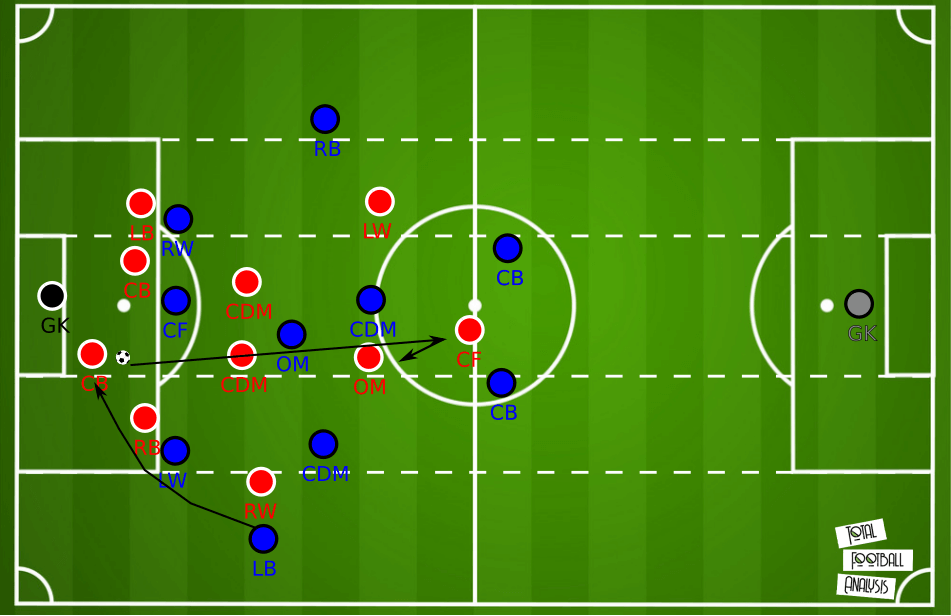
Even if the opponent does not rely heavily on attacking transitions, all good teams will take it when it’s available. Statistically speaking, a team is more likely to score with limited passes and time in goal-scoring actions than through brilliant sequences of play. There’s a reason the latter dominate the highlight reels and social media. They’re really difficult to achieve. Knowing that any opponent will take space as you offer it, attention to detail, knowing the key players and patterns in the counterattack, will help your side take away, or at least limit, quick breaks in favour of the opposition.
Defensive transitions
Determining the counter-pressing abilities of the opponent is vital to your team’s attacking transitions. Identifying the speed of transition will give you an idea of your side’s likelihood of success as you recover the ball. PPDA (passes per defensive action) is a great stat to gauge the counterpressing of the other team. If they have an expansive attack, but are slow to counterpress, punish them in transition. On the flip side, if they’re a strong counterpressing side, your objective is to find outlets to secure possession, either by a progressive pass or retention through short and intermediate-range combinations.
One of the key things to look for is the attacking shape of the opposition. What does their team shape look like in the middle third and how much more aggressively do they push forward in the attacking third? Do they look to assume an expansive shape early in possession or are they more likely to secure the ball and gradually increase their width and verticality? Which players push high up the pitch? Answering these questions will help you identify spaces to attack. As players move higher up the pitch, gaps emerge, especially in the wings and half spaces.
Set pieces
Attacking set pieces
With regards to attacking set pieces, offering the players visuals and training against direct kicks, indirect kicks and corners will naturally fit into your opposition scout reports and subsequent training. Set piece preparation doesn’t end there. Throw-in and kickoff patterns should also factor into your report. These latter two areas will need less coverage than the first three mentioned, but, nonetheless, they fit into the report, even for a brief reference. Long throws should receive comparable attention to free kicks from the wings.
Turning to the specifics, diagramming reoccurring routines, highlighting dangerous players and accounting for movements and picks give your players an idea of what’s ahead. While some sides have balanced routines, others tend to focus on deliveries into a certain area or to specific players. If you have the capacity to compile a highly detailed report, knowing which plays or targets a specific kick taker will target helps massively.
Defensive set pieces
Does the opponent use zonal, semi-zonal or man-oriented marking? How does the opponent assign players for marking, by height, quality or possibly another method? For corners, do they place players on the posts? Do players in the wall jump? Which players feature in the wall, which marking? Does the side cover the goalkeeper when a shot is taken or can we take advantage of rebounds? Is the goalkeeper aggressive in collecting or punching deliveries into the box or is he more likely to stay on his line?
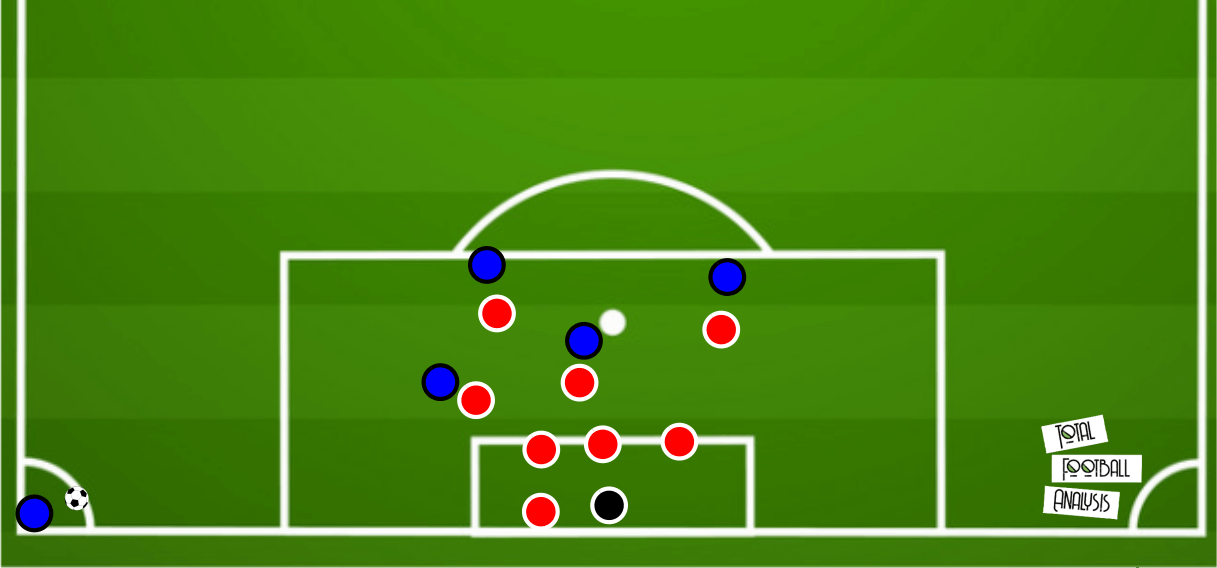
Lots of questions, sure, but answering them is generally a rather quick process. This, again, is a case where knowing the opponent gives you work through advantages and threats, then present those ideas to the squad in a concise manner.
Player profiles
This is an opportunity to inform the squad of the individuals they’ll encounter on the pitch. As a staff of analysts or coaches, this is the place to succinctly list any strengths or weaknesses in the opposition’s players. Since your entire team should read this section, the information should offer just the highlights. Keep it short, keep the players’ attention.
Say your side is preparing to face Juventus. You’ll want to create a profile for any player who has a reasonable shot of featuring in the side. Here’s an example of a player profile for Ronaldo:
“Excellent movement in and around the box. Must track him. Drops to help with build-up, but always present as Juventus attacks the box. If the ball’s on his side, look for switch and CR7’s entry into the box. Dangerous in the air. We can exploit his defensive presence.”
Player profiles point to key personal characteristics. They can also, though briefly, present key data points. Since we have already covered the tactical system, these profiles aim to explain how the individual’s key characteristics are utilised within the greater framework. A few sentences or bullet points will generally do the job.
Pattern play
Since you’ve already detailed the phase-specific tactics early in your research, this is where you can create images for some of the more prominent patterns. Each pattern will consist of phase-specific implications, something the staff should note when titling the visual. Some patterns will be more general to a phase, others will go a step further, highlighting specific objectives and patterns tailored for zone or player specific combinations. Some groups of players, such as wing or forward pairings, may even have go-to combinations or movement patterns that they actively seek.
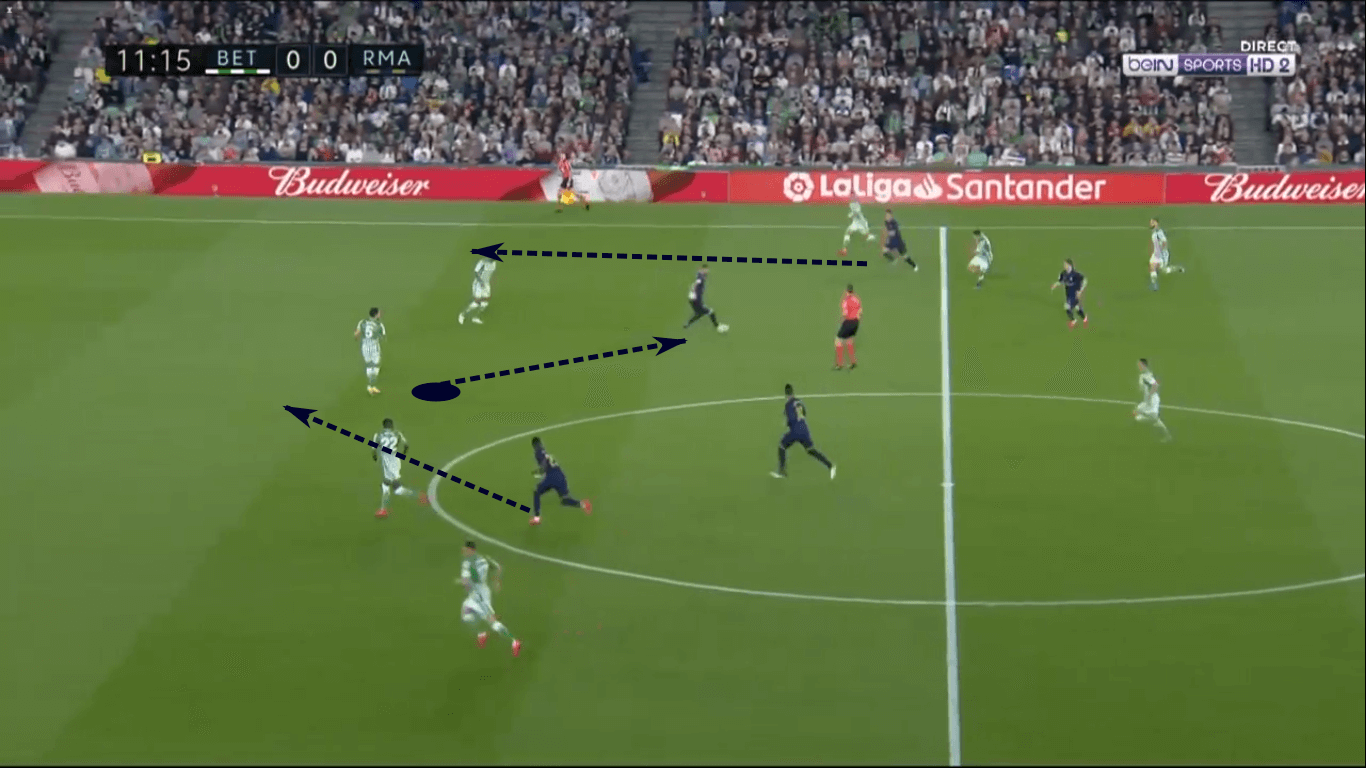
The more general patterns should go to the whole team, whereas zone or player specific patterns are more valuable to the players who have to deal with those threats. If playing against Real Madrid, showing Karim Benzema’s deep drops in the midfield, opening space for his #7 or #11 to run into won’t appeal to your #9. A targeted approach, feeding players only the amount of information they can handle, is critical. Information overload can only hamper performance.
Situational adjustments
Depending on the point of the season or recent changes to the squad or coaching staff, you might have limited data in this area. However, it’s best to understand how the opposition will respond in certain situations. If information is limited, knowledge of the coach will likely provide insight into how he adapts as the match progresses. He has tendencies. Uncover them and you can plan against his adjustments.

Since most of the preceding work covers the general playing philosophy and patterns, this section is an opportunity to show how the opponent adjusts within certain parameters. Scaling the scoreline from +3 to -3 (+2 to -2 at the very least), showing substitution patterns and tactical adjustments and accounting for the opponent’s desired result factor here. If you’re a top side drawing against a mid-table team in the 70th minute, you’ll likely see them park the bus and play opportunistically. From their perspective, a point is better than nothing.
If your team already knows which tactical and personnel changes the opposition will make, correlating them with specific match situations, you can create conditional plans beforehand.
Red teaming
When Bryce G. Hoffman was interviewed on one of my favourite podcasts, red teaming came to my attention. His book, “Red Teaming: How Your Business Can Conquer the Competition by Challenging Everything”, expands on a tactic with military origins. In a sense, red teaming is a laicised version of wargaming. Major corporations, such as Microsoft, and federal governments engage in red teaming to identify threats and adapt their tactics before any damage is done.
As your staff completes the opposition scout reports, uncovering every detail in the opposition’s tactics and personnel, assigning a red team within your staff adds a necessary dynamic to your preparations. Your red team must engage your tactics from the opponent’s point of view. They must use their newfound knowledge of the opponent to determine how he, as the opposition coach, would set up his tactics against your side. Since you should already have a well-developed idea of the opposition’s tactics, the red team’s job is to find the holes in your tactics.
Challenging the staff’s approach carries a number of benefits. First, if there is a hole in your side’s tactics, it’s the red team’s job to find it before the opponent. Second, red teaming challenges assumptions, forcing the club to account for potential threats and breakdowns fully. Third, the red team can bring up alternative tactics, pointing to unforeseen weaknesses within the side that the opposition are likely to attack. As an example, think back to the UEFA Champions League fixture between Real Madrid and Manchester City. Pep Guardiola’s use of a 4-4-2 in defence while shifting Gabriel Jesus to the left wing caught the Spanish side by surprise. Though this was a drastic move, one that any analyst and coaching staff would find difficult to predict, red teaming’s job is to leave no stone unturned. Knowing how you would set up the opposition to counter your own tactics does just that.
Delivery
If your delivery is as drawn out as this article, toss it and head back to the drawing board. Know what your group can handle, both collectively and individually. Attention spans are always hindered in group settings, so finding the right balance between information inundation and scarcity is key.
Video sessions delivering the concepts and preparing the players for the training session are essential. If the information for the group is pragmatic and transitions well to your training ground activities, you’re more likely to keep their attention. Short clips highlighting phases of play and the opposition’s patterns will prepare your players to apply the information on the field, increasing the odds that they’ll remember the key points.
Footage on key individual players is also helpful, but only if the highlighted players are so central to the opposition’s tactics that film study is necessary. If no one player fits the bill, individual video study is preferable.
With regard to individual film studying, this is another area that requires flexibility. For top-level professional teams, each player would benefit from a brief video highlighting the key opponents and opposition patterns he’s most likely to see. If the player collects the footage himself, even better. If they annotate the footage, sharing their tactical connections, you’re well on your way to a tactics masterclass. Taking ownership enhances a player’s understanding, allows for better recall and encourages them to identify their opponent’s tells.
Remember that your tactical planning means nothing if the players don’t understand or remember the information. Short and sweet is preferable, direct application is necessary and encouraging the players to take ownership of their performance are keys to success.
Conclusion
In the spirit of Mourinho and Villas-Boas’ penchant for tactical detail, this article on creating an opposition scout reports offers an ideal, comprehensive level of detail. Not all clubs have the large scouting budgets of the world’s elite. Nor do they have over a hundred analysts on staff as we do at Total Football Analysis. Whereas elite teams and Total Football Analysis can create comprehensive reports within a 48-hour window, most clubs aren’t that lucky.
Scaling the level of detail for your staff is an important first step. If this is too great a burden, third party analysis companies, like our company, offer programs to allocate resources efficiently and secure results.
The detail level is up to each club’s staff, primarily centring on capabilities and resources. It’s possible to reduce some aspects of this report, but the greater your knowledge of the opposition, the greater your chance of getting a result. Knowing the opposition and effectively communicating the details to your team is vital to success. Preparation is key, and detail is king.




Comments